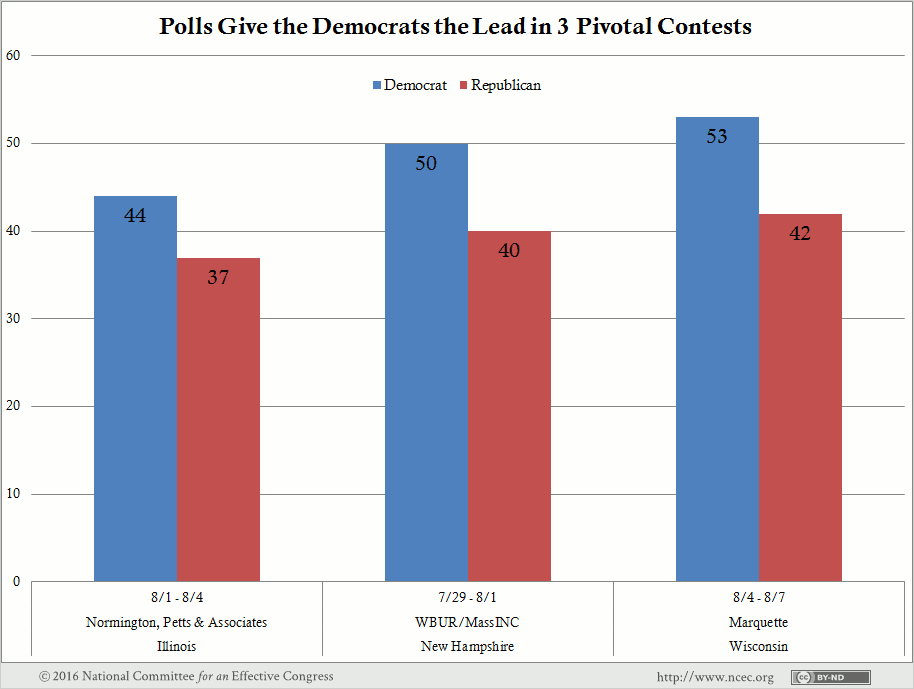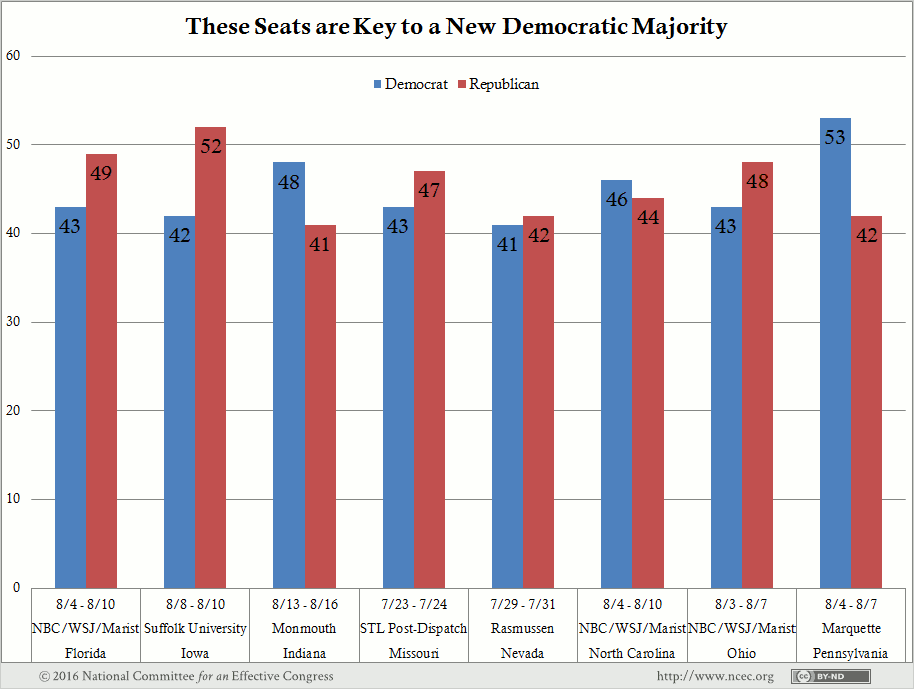Democrats are poised to regain control of the US Senate in 2016. The ongoing implosion of the Trump presidential campaign has complicated the reelection prospects of several Republicans, especially those in Democratic leaning states. But maintaining control in 2018 and beyond will be increasingly difficult.
Democrats need 5 seats to win back an outright majority and Republicans are already trailing in a number of races. In Wisconsin, where Senator Ron Johnson is in a rematch with former Senator Russ Feingold, polls show Feingold in the lead. Similarly, Rep. Tammy Duckworth is leading Senator Mark Kirk in Illinois, where Hillary Clinton may be headed to a double digit victory. In New Hampshire, Republican Senator Kelly Ayotte looks to be in a precarious position as well. A recent poll revealed that Democratic Governor Maggie Hassan leads Senator Ayotte by 10 points. This demonstrates the potential impact of Hillary Clinton’s coattails in New Hampshire, as another poll showed Donald Trump trailing her by 15-points in the state.

If Democrats win all three of the aforementioned seats, and hold on to the tight open seat contest in Nevada between Catherine Cortez Masto and Rep. Joe Heck, they would need to achieve just 2 more victories to regain the US Senate. Possibilities include the close race in Ohio between Republican Senator Rob Portman and former Governor Ted Strickland and Pennsylvania where a close contest has developed between freshman incumbent, Pat Toomey and former Obama environmental official, Kathleen McGinty. Evan Bayh’s decision to enter the race in Indiana has given the Democrats an unexpected pickup opportunity in a traditionally red state. Beyond that, North Carolina, Florida, Iowa, and even Missouri represent other potential Democratic pickups.

While achieving a new Senate majority would be a great victory for Democrats, it’s never too early to start looking into the future where such a thin majority will be hard to maintain. If Democrats emerge with 51 – 53 seats after November, the 2018 landscape may be even more daunting than in 2014, when the Republicans gained 9 seats.
Historically Republican States
Consider the five Senate seats in historically Republican states that Democrats must defend:
Heidi Heitkamp (North Dakota): Governor Jack Dalrymple is waiting in the wings to challenge her.
Joe Donnelly (Indiana): Having been elected against a divisive candidate, who unseated popular incumbent Richard Lugar in a primary fight, the Republicans are likely to find a better candidate in 2018.
Claire McCaskill (Missouri): Will the incumbent Democrat retire or face a very difficult race. Remember that Missouri was the deciding state in the 2002 US Senate battle that unseated Democrat Jean Carnahan. In her last race McCaskill benefitted greatly from former Republican candidate Todd Akin’s unforgettable political collapse.
Jon Tester (Montana): Defending this rural, red state in a non-presidential year is obviously a difficult task. Former Governor Marc Racicot and Rep. Ryan Zinke are potential opponents.
Joe Manchin (West Virginia): West Virginia is never an easy state for Democrats and Joe Manchin is sure to be a top-tier Republican target in 2018. Manchin will have a more difficult race than in 2012 when he faced blunder prone businessman John Raese.
Swing States
In swing states, Democrats also face hurdles:
Tammy Baldwin (Wisconsin): Senator Baldwin was elected in a presidential year but former Democratic US Senator Russ Feingold was defeated in the 2010 landslide. Will Rep. Sean Duffy or another strong Republican challenge Baldwin in 2018 when she doesn’t have the benefit of a presidential year’s Democratic turnout? Obviously national political winds will have a huge impact on this race.
Bill Nelson (Florida): Currently 73 years old, Senator Nelson could potentially retire and place this race high on the Republican target list.
Sherrod Brown (Ohio): Senator Brown seems likely to face a serious challenge in a non-presidential year. Governor John Kasich could make this extremely competitive should he enter the race.
Tim Kaine’s replacement (Virginia): This represents the biggest mystery of all due to the upcoming special election to replace Democratic Vice Presidential nominee Tim Kaine. The winner will face a general election campaign the following year. In a non-presidential year, both the potential 2017 special election and 2018 midterm election will be tough fights. Always popular, Senator Mark Warner was nearly upended by Ed Gillespie in 2014, which showcases how different the midterm electorate can be in Virginia.
The only Republican incumbents who seem vulnerable at this point in time are Jeff Flake in Arizona and freshman Senator Dean Heller in Nevada. Flake is an unrelenting opponent of Donald Trump and is likely to face a serious primary challenge. Nevada continues to trend more Democratic, yet Heller may benefit from a non-presidential year turnout, which will likely be increasingly white.
The bottom line is that if Democrats win less than 53 seats this November, their newfound Senate majority will be in jeopardy in two short years.
